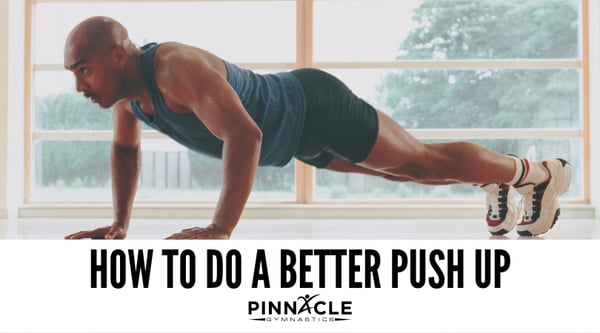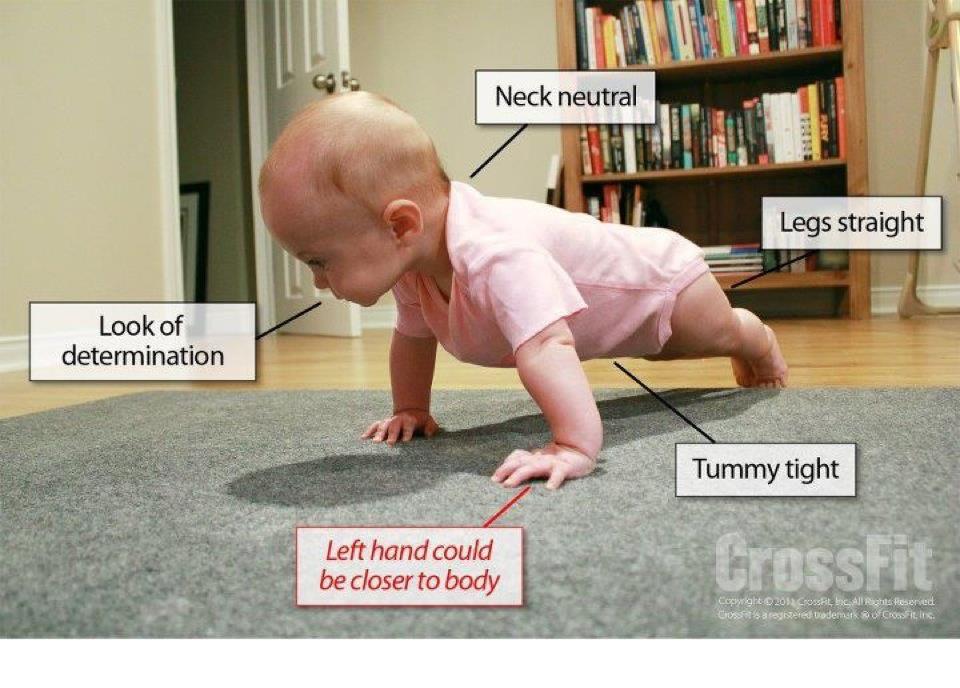How To Do a Better Pushup
Fundamental exercises that have been around forever are sometimes expected to be done without ever really being taught. I know that earlier in my coaching career I expected my athletes to know how to do certain things because I was under the impression that they were taught in P.E. classes during school. Much to my disappointment I have realized that I have to break the skills down to teach them (again or for the first time) so that the athlete can get the benefits that I am certain will come from knowing how to do the skills properly. Today I will be tackling the standard pushup. "Why" you may ask. Well, in my experience, I get asked the question, "What can we be doing at home to help Sally Sue get better at Gymnastics/Tumbling Classes?" This will hopefully be a series of blogs that go over some basic exercises (Squats, Pull Ups, Planking, etc) that are safe to do at home as well as hugely important for the little ones athletic training. You may even benefit from doing them along side your superstar.

Keys to a good Push up
A good push up can be a little more complicated that one might initially think. How are your shoulders, your hand placement, your trunk control, where do your elbows go? I will try to quickly go over these points as well as others to give you the optimal standard pushup.
Starting Position
To start a standard pushup you will need to be able to focus on a few things one after the other to get in the correct position. First, while kneeling on both legs, place your hands on the ground about the width of your shoulders. Next, lean forward to place more weight on your hands and extend your legs behind you with your toes curled so the weight is on the upper ball of your feet as well as toes. Now for the checklist: Feet & legs should touching each other, your hips should be in a straight line from the heels to the head. Shoulders should be just in front of your hands, directly below your shoulder, and your spine should also be straight (hips, lower back, upper back, neck) like if you were lying on your back. Now, how much are you squeezing your quads? your hamstrings? your glutes? your abs? All these muscles should be flexing without movement. This one is a bit tricky but, when you squeeze your pecs, do your hands rotate? They should be flat and running in the same direction as your body. Most experts say that the middle finger should be parallel to the spine and thumb perpendicular to the body. I know, technically there are loads of variations to the hands but this is the standard pushup, OK!?!
Lowering and Pressing
Once you've successfully mastered the Starting position you will be ready for the next phase which is the lowering phase. Keeping everything in a tight straight line, bend the elbows back towards your heels & hips. (wait, what?) Yup I do not want your elbows to flare out to the sides.
I want you to keep your elbows tucked to your sides. Main reason is that we want to protect the shoulder from developing an impingement that will later negatively affect gymnastics skills. The next reason is that I want to engage the triceps as much as possible as well as the anterior deltoid. As you reach the floor, only the chest should touch, not the hips or thighs. Your wrist may be feeling a stretch at this point as the thumbs should be inline with you pectoralis (commonly called the nipple line). Keeping your torso extremely tight and pulling your toes slightly towards your head thus locking your body in that straight, tight line for the entire movement. Last part of the lowering phase is breathing. Inhale over the course of lowering yourself to the floor.
Pressing, exhaling on the way up. You should feel your shoulders (deltoids) tighten more, triceps pressing, and your pecs & Latissimus Dorsi flexing as well. The whole body lifts to the top position again without ever changing shape.

Benefits and Programming
In general you will reap tons of benefits of doing good quality push ups. The first is building a stronger upper body to withstand the impacts of gymnastics and tumbling. Your posture is likely to improve and with all of our device using and sitting that we all do now a days, we can all work more on our posture. Running, yes I said running, with that deltoid work, then moving the arm back and forth closer to the body then you can use your arms more and longer when you run. Wrist flexibility, you lose it if you do not use it. It seems like every adult that I talk to after taking an adult gymnastics class or tumbling class asks me what they can do to keep their wrists from hurting. Good push ups will definitely help.
Now how many push ups should one do? That is a great question and one that could be debated the most. You can find all kinds of push up plans on Pinterest or whatever but I would advise you to start with a goal of getting 10 quality push ups with no rest. Then change the pace of those ten, say half speed down and half speed up. Then quick ones with 10 second break between each push up. Once you've mastered 10 go for 20, ultimately going for a solid 30-50 reps at a time. Next would be to throw in modifications like hand placements, declines, single leg, etc. Always remember quality over quantity, near perfection before progression.
For more ideas:

